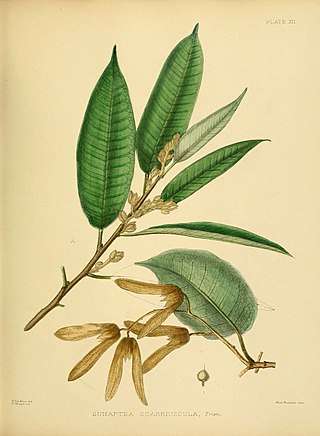Anisoptera laevis is a tree in the family Dipterocarpaceae. The specific epithet laevis means "smooth", referring to the leaves.
Anisoptera marginata is a tree in the family Dipterocarpaceae. The specific epithet marginata means "bordered", referring to the leaf veins.
Anisoptera reticulata is a tree in the family Dipterocarpaceae. The specific epithet reticulata means "netted", referring to the leaf veins.

Campylospermum serratum is a plant in the family Ochnaceae. The specific epithet serratum is from the Latin meaning "with teeth", referring to the leaf margin. It is found in Tropical Asia, from Sulawesi, Indonesia to Hainan, Zhōngguó/China and over to southwester India. Gomphia serrata was a previous common name for the species. The plant is used for it wood and its sap is used in folk medicine and in the past for teeth-blackening.

Hopea beccariana is a species of tree in the family Dipterocarpaceae. It is named for the Italian botanist Odoardo Beccari.
Hopea griffithii is a tree in the family Dipterocarpaceae. It is named for the British doctor and naturalist William Griffith.
Hopea mesuoides is a tree in the family Dipterocarpaceae, native to Borneo. The specific epithet mesuoides refers to the species' resemblance to the genus Mesua.
Hopea micrantha is a tree in the family Dipterocarpaceae. The specific epithet micrantha means "small flower".
Hopea pedicellata is a tree in the family Dipterocarpaceae. The specific epithet pedicellata, refers to the species' prominent pedicel.
Hopea pentanervia is a tree in the family Dipterocarpaceae, native to Borneo. The specific epithet pentanervia means "five-nerved", referring to the species' five pairs of leaf veins.
Hopea sangal is a tree in the family Dipterocarpaceae. It is native to tropical Asia.

Maranthes corymbosa is a tree in the family Chrysobalanaceae. The specific epithet corymbosa is from the Greek meaning "cluster", referring to the clustered inflorescences.

Cotylelobium is a genus of plants in the family Dipterocarpaceae. The name Cotylelobium is derived from Greek and describes the receptacle. It contains five species distributed in Sri Lanka, Peninsular Thailand, Sumatra, Peninsular Malaysia and Borneo. All five species are listed on the IUCN redlist, as either vulnerable, endangered or critically endangered.
Cotylelobium lanceolatum is a tree in the family Dipterocarpaceae. The specific epithet lanceolatum means "lance-like", referring to the shape of the leaf.

Kopsia arborea is a tree in the family Apocynaceae.
Helicia attenuata is a plant in the family Proteaceae. The specific epithet attenuata means "drawn out", referring to the leaf base.
Castanopsis javanica, the Javan chestnut-oak, is a tree in the beech family Fagaceae. The specific epithet javanica is from the Latin, meaning "of Java".
Vatica albiramis is a tree in the family Dipterocarpaceae, native to Borneo. The specific epithet means "white twigs".
Hopea treubii is a tree in the family Dipterocarpaceae, native to Borneo. It is named for the Dutch botanist Melchior Treub.
Symplocos cerasifolia is a plant in the family Symplocaceae, native to Southeast Asia. The specific epithet cerasifolia refers to the leaves' resemblance to those of a cherry tree.





